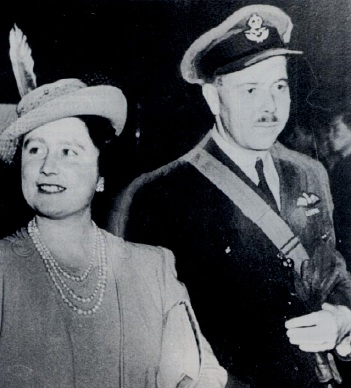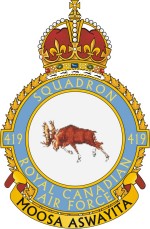 Aircrew Chronicles
Aircrew Chronicles  |
Aircrew Losses
|
Nose Art
|
BCATP
|
Lancaster
|
Media
|
Aircrew Losses
|
Nose Art
|
BCATP
|
Lancaster
|
Media
 Aircrew Chronicles
Aircrew Chronicles  |
Aircrew Losses
|
Nose Art
|
BCATP
|
Lancaster
|
Media
|
Aircrew Losses
|
Nose Art
|
BCATP
|
Lancaster
|
Media
Bomber Command Aircrew Chronicles

|
In any book about Canadian fliers it would be impossible to omit Wing Commander John "Moose" Fulton of the RAF. For he was the great Moose, the granddaddy of a hundred young RCAF fliers and one of the most beloved men to wear the King's uniform. He already belongs to legend, to an hour in distant time past when the war was still new and uncertain and we all sang, "There'll Always be an England" with a strange feeling of un-reality. Perhaps these words make him sound soft. Perhaps he was, at heart. But it was no quality of softness that won for John Fulton the Distinguished Service Order, Distinguished Flying Cross, and the Air Force Cross. Flying was his life; had been since the first times he dreamed of it while tramping though the great woods around Kamloops, B.C. A great healthy boy who spent much of his youth hunting and fishing, Moose was never meant for the indoors. He tried it for a while after completing his senior matriculation. At sixteen years of age he went to work as a junior clerk in a bank in Kamloops. |
But it wasn't for the Moose. After a year he cut loose and went down to the Boeing School of Aeronautics in Oakland, California.
His first contact with the military was as a trooper in the B.C. Hussars. He was very much attracted to the type of life, and in 1934 combined his two first loves by going to England and the Royal Air Force. In 1935 Moose was commissioned as a pilot officer and after training joined a bomber transport squadron in Egypt. He remained there for just over two years, enjoying the pleasant peacetime life of the RAF.
At the outbreak of war he was back in England flying with a bomber squadron. When the pace began to speed up Moose flew in twenty major operations in three months and in September of 1940 was awarded the Distinguished Flying Cross. He received the Air Force Cross in January of 1942, and on August 4th of that year was awarded the Distinguished Service Order for attacks on industrial centres, dockyards, towns, aerodromes, and other important enemy targets.
When the RCAF's No. 419 Squadron was organized, its executive officers were Canadians loaned by the RAF. The first commanding officer of this great squadron was the freckled, ginger-haired, soft-spoken, slow-gaited man known as Moose. His popularity is now part of the legend. Wherever the Moose went the crowd moved with him. He was the object of equal affection from group captains and sergeants. And both stood about the same in the great democratic regard of the Moose.
The story of John Fulton includes more than fifty operational bombing sorties, many of them filled with the incredible incidents that befall every bomber crew. He remained long enough to take part in the early thousand bomber raids on Cologne, Bremen, and the Ruhr. In these, as in most of his operations, he flew a Wellington, a twin-engined, stable aircraft that formed the backbone of Bomber Command's early efforts.
On one occasion he was returning from a raid on Kiel when his aircraft was seriously damaged at fifteen hundred feet and forced to yield altitude. The Moose, apparently unperturbed, flew a hazardous hundred and eighteen miles with the wave-tops of the North Sea licking at the belly of the machine. Such episodes didn't seem to disturb him any more than did his triple decorations, which he explained by saying, "I didn't have any decorations and I suppose the blokes higher up thought I would be nice if they gave me some."
On 28/29 July 1942, Moose went to Hamburg. On the way home enemy night fighters picked him up, and just after four o'clock in the morning the aircraft sent out this final message from Moose, "Wounded . . .fighters . . . five hundred feet."
The Moose and his crew had bought it.
When it became known that he was down in the sea, the exhausted men of No. 419 requested permission to go right back out and commence a search. But the job belonged to Air-Sea Rescue and the boys were ordered to bed.
In the days of John Fulton the men of No. 419 Squadron called themselves Moosemen. By 1943 there was not a single member of No. 419 who had been there in those times, but the new fliers were still proud to call themselves Moosemen.
They do today.

|
The high esteem in which the men of No.419 Squadron held their missing leader was demonstrated by the adoption of his nickname as their own thus immortalizing the first commanding officer of "Moose" Squadron for all time. No. 419 was the only Canadian squadron to be named after a person. 419 Tactical Fighter (Training) Squadron currently conducts Phase IV of the NATO Flying Training Canada program for Canada, Denmark, Italy, Singapore and the Royal Air Force at 4 Wing in Cold Lake, Alberta. This program prepares future fighter pilots for training on CF-18 class aircraft. |